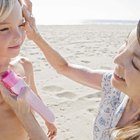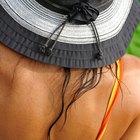During the past three decades, suntan beds and booths have became very popular. Women (and men, too) have summertime tans in the middle of winter thanks to this invention. According to Hottestacne.com, Friedrich Wolff introduced tanning beds to America in 1978. Originally, tanning beds were not regulated, but since 1988 they have been. However, if you frequent a tanning bed or booth, you might come out with more than you bargained for, including a skin rash.
Considerations
Be aware that tanning beds emit anywhere from 93 percent to 99 percent UVA radiation, which is considered three times the UVA radiation that you are exposed to when out in the sun.
Possible Outcome
The rashes that can occur are the result of an allergic reaction to UV or ultraviolet light that is used in the tanning bed. When you have an allergy to UV rays, this is called sun poisoning or photodermatitis, according to Organizedwisdom.com.
Potential
Warts can be contracted in a tanning bed that has not been properly cleaned and sterilized, according to the Mayo Clinic's Dr. Dawn Davis, a dermatologist. Warts are caused by HPV, which is the human papillomavirus. Davis says that she has seen patents who were severely burned and scarred as a result of using a tanning bed, as well as a number infections that were contracted from the tanning bed. Cellulitis, which is a skin infection caused by staphylococcus bacteria, skin ulcerations and rashes can also be caused by tanning beds.
Risks
Aside from skin rashes, the UVA and UVB rays can damage the eyss' retinas and cause cararacts. Davis adds that using a suntan bed can increase your risk of acquiring melanoma (skin cancer) by eight times during your lifetime. Some physicians equate using a tanning bad to lying naked on a hot skillet right after someone else has done the same thing, according to Keloland.com.
Effects
UVA rays are considered less dangerous than UVB rays, but UVA light can penetrate deeper into your skin, according to Cig.cnn.com. This can result in actinic keratosis, which increases your chance of developing skin cancer. Furthermore, tan accelerating products should be avoided, according to the Food and Drug Administration.
Expert Insight
If getting a rash isn't enough to dissuade you from using a tanning bed, consider what Dr. Stephen E. Chiarello, a dermatologish in southwest Florida, has to say. He notes that the deep penetrating UVA rays cause damage to the skin’s tissue and lessens elasticity, as well as augments skin cancer growth. The skin thins and wrinkles when tanning beds are used excessively.
Related Articles

Baby Oil & Tanning

Negative Side Effects of Paba

Can Borage Oil Help Acne?

The Quickest Way to Get a Tan Without ...

Dangers of Spray on Tan

Why Does the Tanning Bed Make You Happy?

Is it Better to Tan With or Without ...

Difference Between Bronzing & Tanning ...

Long-Term Health Risks of Laser Hair ...

Uva Vs. Uvb Tanning Beds

Herbs That Cause Photosensitivity

Sunbed Pros & Cons

Bronzer Vs. Turbo Tanning Bed

What Creams Can I Use at Home After ...

Effects of Flaxseed Oil on Skin Wrinkles

What Are the Treatments for Glycolic ...

How Many Times Should I Tan in a ...

What Is Aloe Good For?

UV Tanning Vs. Spray Tanning

What Do You Use to Help You Tan in the ...
Writer Bio
Cindi Pearce is a graduate of Ohio University, where she received her bachelor’s degree in journalism. She completed both the undergraduate and graduate courses offered by the Institute of Children’s Literature. Pearce has been writing professionally for over 30 years.